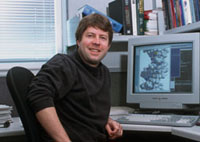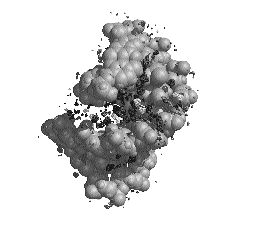Thomas Cheatham, III
Professor of Medicinal Chemistry and Adjunct Professor of Biomedical Engineering
Biomolecular Simulation, Computational Chemistry

Biological Chemistry Program
Education
B.A. Middlebury College
Ph.D. University of California, San Francisco
Research
Our research involves the development of molecular dynamics and free energy simulation methodologies (AMBER and CHARMM) and their application to proteins, nucleic acids and lipids in their native environments. Thanks to advances in computer power, empirical force fields for bio-molecular systems, and methodological enhancements, we have witnessed tremendous advance in our ability to reliably represent the structure, dynamics, energetics and interactions of a wide variety of systems. Despite these advances, there are still major issues related to the energetic representation and the sampling of thermally accessible conformations. Through the application of these methods to bio-molecular systems we not only expose these deficiencies and investigate means to overcome them, but provide insight above and beyond what can be seen experimentally. Specific areas of recent interest include: (a) the environmental dependence of nucleic acid and protein structure, (b) investigation of the pathways of complex conformational transitions and (c) the role of flexibility and dynamics in structure and function.

Average hydration (blue), ethanol oxygen (red) and Na+ ion association (yellow) around an average DNA structure from a two nanosecond MD simulation.
Environmental Dependence of Nucleic Acids
The structure and dynamics of nucleic acids are profoundly influenced by their environment: small changes in the salt concentration or identity, hydration or protein binding can radically alter the properties of DNA. Recently, we have shown that molecular dynamics simulations can reproduce these structure alterations, giving detailed insight into the process. Currently, work is underway to investigate the specific role of ion binding on DNA bending.
Forcing conformational transitions
The rough and complex energy surface of biological macromolecules, coupled with computational limits that restrict accurate simulation to the 1-50 ns time range, inhibit the spontaneous observation of large and functionally important structural changes. To enhance sampling, we are developing and applying methods that allow unbiased searching of complex conformational transitions, such as propagation of a B-DNA/Z-DNA junction and the structural changes induced by prolyl isomerases.
Flexibility in structure and function?
Contrary to the static picture of bio-molecules seen from the millisecond time averaged structures from crystallography or NMR, bio-molecular structures are extremely dynamic. MD simulations coupled with other methods, over various time scales, can give detailed insight into role of macomolecular dynamics and ultimately how to modulate them to alter function.
References
- Galindo-Murillo R, García-Ramos JC, Ruiz-Azuara L, Cheatham TE 3rd, Cortés-Guzmán F. Intercalation processes of copper complexes in DNA. Nucleic Acids Res. pii: gkv467. (2015).
- Galindo-Murillo R, Roe DR, Cheatham TE 3rd. On the absence of intrahelical DNA dynamics on the μs to ms timescale. Nat Commun. 5, 5152. (2014).
- Galindo-Murillo R, Roe DR, Cheatham TE 3rd. Convergence and reproducibility in molecular dynamics simulations of the DNA duplex d(GCACGAACGAACGAACGC). Biochim Biophys Acta. 1850(5), 1041-58. (2015).
- P Stadlbauer, L Trantírek, TE Cheatham, J Koèa and J Sponer. "Triplex intermediates in folding of human telomeric quadruplexes probed by microsecond-scale molecular dynamics simulations." Biochimie ASAP (2014) doi:10.1016/j.biochi.2014.07.009.
- A Okal, S Cornillie, SJ Matissek, KJ Matissek, TE Cheatham, III and CS Lim. "A re-engineered p53 chimera with enhanced homo-oligomerization that maintains tumor suppressor activity." Mol. Pharm. 11(7), 2442-2452 (2014).
- NM Henriksen, H Hayatshahi, DR Davis, and TE Cheatham, III. "Structural and energetic analysis of 2-aminobenzimidazole inhibitors in complex with the hepatitis C virus IRES RNA using molecular dynamics simulations." J. Chem. Info Model. 54(6), 1758-1772 (2014).
- J Thibault, TE Cheatham, III, and JC Facelli. "iBIOMES Lite: Summarizing biomolecular simulation data in limited settings." J. Chem. Info Model. 54(6), 1810-1819 (2014).
- R Galindo-Murillo and T.E. Cheatham, III. "DNA-binding dynamics and energetics of Co, Ni, and Cu metallopeptides" Chem. Med. Chem. 9(6), 1252-1259 (2014).
- DR Roe, C Bergonzo, and T.E. Cheatham, III. "Evaluation of enhanced sampling provided by accelerated molecular dynamics with Hamiltonian replica exchange methods." J. Phys. Chem. B 118, 3543-3552 (2014).
- JC Thibault, DR Roe, JC Facelii and T.E. Cheatham, III. "Data model, dictionaries, and desiderata for biomolecular simulation data indexing and sharing." J. Cheminformatics 6 (2014) doi:10.1186/1758-2946-6-4.
- R Galindo-Murillo, C Bergonzo and T.E. Cheatham, III. "Molecular modeling of nucleic acid structure: Setup and analysis." Cur. Protocols Nucleic Acid Chemistry 56: 7.10.1-7.10.12 (2014).
- C Bergonzo, N Henriksen, D Roe, J Swails, AE Roitberg, and T.E. Cheatham, III. "Multi-dimensional replica exchange molecular dynamics yields a converged ensemble of an RNA tetranucleotide." J. Chem. Theory Comp. 10, 492-499 (2014).
- N Ashton, DR Roe, R Weiss, TE Cheatham III and R. Stewart. "Self-tensioning aquatic caddisfly silk: Ca2+-dependent structure, strength, and load cycle hysteresis." Biomacromolecules 14, 3668-3681 (2013).
- TE Cheatham, III and D.A. Case. "Twenty-five years of nucleic acid simulations."Biopolymers [in press] (2013).
- D Roe and TE Cheatham, III. "PTRAJ and CPPTRAJ: Software for processing and analysis of molecular dynamics trajectory data." J. Chem. Theory Comp. 9, 3084-3095(2013). ...the long awaited PTRAJ paper!
- J Sponer, A Mladek, N Spackova, X Cang, TE Cheatham, III and S. Grimme. "Relative stability of different DNA guanine quadruplex stem topologies derived using large-scale quantum-chemical computations." J. Amer. Chem. Soc. 135, 9785-9796 (2013).
- M Zgarbova, F Javier Luque, J Sponer, TE Cheatham, III, M Otyepka, and P Jurecka. "Toward improved description of DNA backbone: Revisiting epsilon and zeta torsion force field parameters." J. Chem. Theory Comp. 9, 2339-2354 (2013).
- P Stadlbauer, M Krepl, TE Cheatham, III, J Koca and J. Sponer. "Structural dynamics of possible late-stage intermediates in folding quadruplex DNA studied by molecular simulations." Nuc. Acids Res. 41, 7128-7143 (2013).
- NM Henriksen, DR Roe, and TE Cheatham, III. "Reliable oligonucleotide conformational ensemble generation in explicit solvent for force field assessment using reservoir replica exchange molecular dynamics simulations." J. Phys. Chem. B 117m 491404927 (2013).
- JC Thibault, JC Facelli, and TE Cheatham, III. "iBIOMES: Managing and sharing biomolecular simulation data in a distributed environment." J. Chem. Info. Model. 53, 726-736 (2013).
